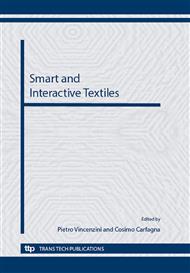p.7
p.14
p.22
p.30
p.39
p.47
p.53
p.59
p.65
Cosmeto-Textiles: State of the Art and Future Perspectives
Abstract:
The skin is the largest human organ. Its care and health are, therefore, essential. The skin can only be healthy and attractive when it is in balance. The pre-requisites for healthy skin are: the moisture content, the protective function, elasticity and cell renewal. All of these parameters are supported by applying pharmaceuticals and wellness substances. Pharmaceutical law defines the former as substances and compositions of substances that are applied to or in the human body to heal, ease, prevent or detect illness, pain, bodily injury or disease symptoms. Wellness substances are substances able to enhance the sense of overall wellbeing in all physical and mental aspects of life, and bring the mind, body and spirit in harmony with the nature. The newest movement in beauty is the hybrid of textiles and cosmetics called Cosmeto-Wear: consumers, especially ladies, expect clothing to have a positive effect on the conditions of their skin. Hence, finishers are being asked to create products that offer new and/or improved functions. In recent years, textile materials with special applications in the cosmetic field have been developed. A new sector of cosmetic textiles is opened up and several cosmetic textile products are currently available in the market. There are essentially two different ways of manufacturing cosmetic textiles, they are the binding of microencapsulated cosmetic components or the fabric coating by active finishes. This paper describes the fabrication technologies of cosmeto-textiles, discussing the choice of active components and the problem of their unwanted loss during washing, as well as the trend of cosmeto-textile industry in view of consumers demands.
Info:
Periodical:
Pages:
39-46
Citation:
Online since:
September 2012
Authors:
Keywords:
Price:
Сopyright:
© 2013 Trans Tech Publications Ltd. All Rights Reserved
Share:
Citation:


